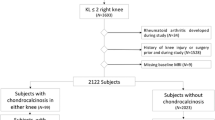Abstract
Purpose
The purpose of this study was to examine gadolinium-enhanced magnetic resonance imaging (MRI) for monitoring cartilage degeneration.
Methods
This is a proof-of-concept study in an animal model. Adult New Zealand rabbits were randomly stratified into five groups. Papain was injected intra-articularly in the right knee in four groups to establish the stages of cartilage degeneration. The left knee and group 5 served as controls. Bilateral MRI was performed 24 h after the initial injection of papain, and 1 week, 1 month, and 3 months following three papain injections. Injection of the contrast agent was followed by bilateral MRI examination immediately upon injection, and at 2 and 4 h post-injection. Signal intensities of articular cartilage and peripheral soft tissues were obtained before animals were sacrificed. Post-mortem bilateral cartilage specimens were studied histologically.
Results
Histopathology results verified the staged degeneration of papain-treated articular cartilage. Differences in cartilage signal intensity were significant for the staged model using a special three-dimensional MRI method (P < 0.05) but not using ordinary MRI. No differences were observed within or between the control groups (P > 0.05).
Conclusions
Contrast-enhanced MRI examination may be a viable tool for early diagnosis of osteoarticular disease. Prospective studies are warranted to evaluate the potential for clinical application.


Similar content being viewed by others
References
Paul PK, O'Byrne E, Blancuzzi V, et al. Magnetic resonance imaging reflects cartilage proteoglycan degradation in the rabbit knee. Skeletal Radiol. 1991; 20: 31–36.
Havdrup T, Telhag H. Papain-induced changes in the knee joints of adult rabbits. Acta Orthop Scand. 1977; 48: 143–149.
Farkas T, Bihari-Varga M, Biro T. Thermoanalytical and histological study of intra-articular papain-induced degradation and repair of rabbit cartilage. II. Mature animals. Ann Rheum Dis. 1976; 35: 23–26.
O'Byrne EM, Paul PK, Blancuzzi V. Magnetic resonance imaging of the rabbit knee: detection of cartilage proteoglycan degradation. Agents Actions. 1991; 34: 214–216.
Miyauchi S, Machida A, Onaya J, Sakamoto T, Tokuyasu K, Iwata H. Alterations of proteoglycan synthesis in rabbit articular cartilage induced by intra-articular injection of papain. Osteoarthritis Cartilage. 1993; 1: 253–262.
Liu S-R, Leng X-M, Huang L. The application of fat-suppressed spoiled gradient echo (3D-FS-SPGR) sequence in association with three-dimensional reconstruction in cartilage disorder of the knee. Journal of Practical Radiology. 2002; 18: 974–977.
Uhl M, Allmann KH, Tauer U, et al. Comparison of MR sequences in quantifying in vitro cartilage degeneration in osteoarthritis of the knee. Br J Radiol. 1998; 71: 291–296.
Disler DG, McCauley TR, Wirth CR, Fuchs MD. Detection of knee hyaline cartilage defects using fat-suppressed three-dimensional spoiled gradient-echo MR imaging: comparison with standard MR imaging and correlation with arthroscopy. Am J Roentgenol. 1995; 165: 377–382.
Samosky JT, Burstein D, Eric Grimson W, Howe R, Martin S, Gray ML. Spatially-localized correlation of dGEMRIC-measured GAG distribution and mechanical stiffness in the human tibial plateau. J Orthop Res. 2005; 23: 93–101.
Squires GR, Okouneff S, Ionescu M, Poole AR. The pathobiology of focal lesion development in aging human articular cartilage and molecular matrix changes characteristic of osteoarthritis. Arthritis Rheum. 2003; 48: 1261–1270.
van der Harst MR, Brama PA, van de Lest CH, Kiers GH, DeGroot J, van Weeren PR. An integral biochemical analysis of the main constituents of articular cartilage, subchondral and trabecular bone. Osteoarthritis Cartilage. 2004; 12: 752–761.
van de Lest CH, Brama PA, van El B, DeGroot J, van Weeren PR. Extracellular matrix changes in early osteochondrotic defects in foals: a key role for collagen? Biochim Biophys Acta. 2004; 1690: 54–62.
Tiderius CJ, Olsson SE, de Verdier H, Leander P, Ekberg O, Dahlberg L. Gd-DTPA2)-enhanced MRI of femoral knee cartilage: a dose-response study in healthy volunteers. Magn Reson Med. 2001; 46: 1067–1071.
Kallioniemi AS, Jurvelin JS, Nieminen MT, Lammi Mj, Toyras J. Contrast agent enhanced pQCT of articular cartilage. Phys Med Biol. 2007; 52: 1209–1219.
Acknowledgment
We acknowledge funding by the National High Technology Research and Development Program of China.
Author information
Authors and Affiliations
Corresponding author
Supplementary Material
Below is the link to the electronic supplementary material.
S-Figure 1
i Group B right knee (treatment) 4 h after injection of gadolinium, scanned with 3D-FS-SPGR. ii Group B left knee (saline control) 4 h after injection of gadolinium, scanning with 3D-FS-SPGR. The treatment side appears clearer than the control side (GIF 31 KB).
S-Figure 2
i Group C right knee (treatment) 2 h after injection of gadolinium, scanned with 3D-FS-SPGR. ii Group C right knee (treatment) 4 hours after injection of gadolinium, scanned with 3D-FS-SPGR: low signal intensity is seen in the cartilage of the lateral condyle of the femur (GIF 32 KB).
S-Figure 3
Group C (1-month group) processing side (right knee): the destroyed fraction of articular cartilage can be seen. The cartilage cells are distributed in a disorderly array, and the cartilage matrix shows fibrosis. (HE ×40) (GIF 58 KB)
S-Figure 4
i Group D (3-month group) processing side (right knee) with T1 weight imaging, plain scan. ii Group D (3-month group) processing side (right knee) with 3D-FS-SPGR, plain scan: the articular cartilage appears thin and may even disappear (GIF 28 KB).
S-Figure 5
i Group D (3-month group) processing (right knee): the cartilage cells show proliferation but the basic structure has disappeared. Fibrosis can be seen. The control group and the blank group also show light degeneration on the articular surface of the cartilage. (HE ×40). ii Group D (3-month group) processing (right knee): acid mucopolysaccharide blue-stain is faint, almost disappearing. (Alcian blue staining ×40) (GIF 123 KB).
S-Table 1
Summarized SIR results for the saline control and the blank control, with SE-T1WI and 3D-FS-SPGR MRI scans (DOC 75 KB)
Rights and permissions
About this article
Cite this article
Liu, S., Shen, S., Zhu, T. et al. Gadolinium-enhanced magnetic resonance imaging of the knee: an experimental approach. Skeletal Radiol 39, 885–890 (2010). https://doi.org/10.1007/s00256-008-0645-y
Received:
Revised:
Accepted:
Published:
Issue Date:
DOI: https://doi.org/10.1007/s00256-008-0645-y




